#geijutsu
Text

Charles Babbage by O-Osaka Geijutsu Daigaku
#o osaka geijutsu daigaku#charles babbage#anime figure#figure collecting#fate#fate series#fate grand order#fgo#fate go#garage kit
22 notes
·
View notes
Photo

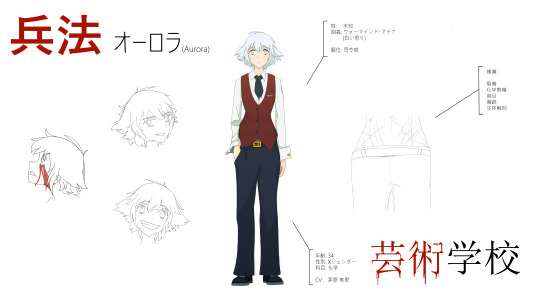
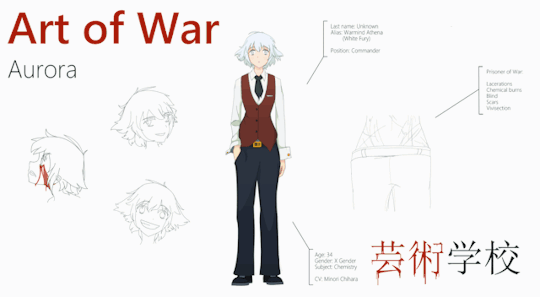
Aurora, the founder of the School of the Arts, and the eccentric chemistry teacher. They may be a bubbly educator during the day, but there are ghosts still riding along the veiled coattails of the war’s end. It just so happens that every teacher could also call themselves some of the deadliest soldiers, sailors, saboteurs, and assassins of the late civil war--who stalk the night looking for the war criminals who continue to roam free.
However, their students just might save them before the costs of vengeance are sowed.
FUN FACT: Aurora is transgender (MtF), and all of the characters refer to them using he/him pronouns except for Aurora’s best friend, Arthur (Principal, former SAS, and fellow ex-prisoner of war). This is an extremely important plot point that gets highlighted in the last season.
#Geijutsu gakko#school of the arts#SotA#Aurora#anime#manga#anime art#trans#lgbtq#lgbt art#original character#oc#War#x gender#animation#animated#character art#character design#character sheet#芸術学校#アニメ#マンガ#イラスト#rabidpelican#digital art
66 notes
·
View notes
Text
「芸術新潮」2月号 特集「会田誠が考える新しい美術の教科書」

現代美術家・会田誠。自身の作品《MONUMENT FOR NOTHING - にほんのまつり》(部分)の前で。 Courtesy of Mizuma Art Gallery
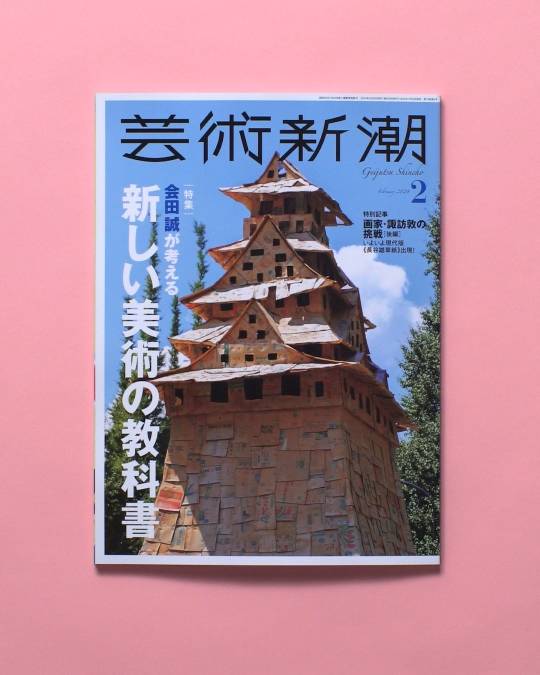
――「芸術新潮」の編集部から、「新しい美術の教科書をつくりませんか?」というオファーを受けた時はどう思われましたか?
会田 おもしろい企画だと思いました。迷うことなく、「やります」と返事をしました。でも落ち着いて考えると、これはなかなか難しいお題だな、とも思いましたね。僕には息子がいて、最近の美術の教科書は実際に見ていたのですが、僕らの時代の教科書と比べると、ずっと良い方向へ進化していると思っていました。僕が何か提案しても、それはもう今の教科書に出ていますけど、ということになりそうで……。
――それで、どのように内容を構想していったのでしょうか?
会田 結果的には、ずばり言ってしまえば、「ドクメンタ」的現代美術の紹介が中心になりました。ドクメンタは、ドイツの田舎町カッセルで4~5年に一度開催されている芸術祭です。つまりは「社会派アート」というようなことになるわけですが、日本の一般社会から、あるいは美術の世界からも比較的無視されがちなジャンルかなと思って、そのあたりを多く紹介することになりました。とはいえ、僕個人が社会派アートが大好き!というわけではありません。ドクメンタには、2002年に1回行ったことがあるだけです。ナイジェリアのキュレーター、オクウィ・エンヴェゾーが欧州人以外で初めて芸術監督をつとめた時でしたが、すべての作品が社会正義を訴えるような、ドクメンタとしてもちょっと極端な回だったようです。「これが芸術? 社会科の発表会じゃないんだから」と、僕はその時は反発しました。しかし僕の作品も、もともとは絵画中心だったものがそうではない形式の作品も増えていって、この20年ほどで、ドクメンタ的な美術もやはりいいなと思うようになりました。第一印象で嫌いだった人がだんだん好きになっていくような感じでしょうか。美術の教科書であれば、まずは「形」と「色」、というのが当然のことだし、僕もそう思っているのですが、今回の教科書では、あえて「形」と「色」については何も語っていません。そして「絵画」と「彫刻」についても、それ自体をテーマとしてはほとんど扱わずに、ドクメンタ的な、社会に拡張してゆく美術を中心に紹介することになりました。
――教科書の「1時間目」のテーマは、「美術に政治を持ち込もう!」ですね。
会田 いちばん最初に出てくる図版が、酒井抱一の《四季花鳥図屏風》です。我ながら節操がなくて笑ってしまいますが、僕はまるで日本絵画大好き人間のような感じで、「死ぬまでにこの目で見たい日本の絵100」という「BRUTUS」の特集を監修していたりするのに、いきなり否定材料として抱一の絵を出しています。日本美術の特徴のひとつに「花鳥風月」があって、それにはいい面もありますが、裏返すと悪い点も抱えている。また、それに続いて、フランス革命と並走して近代芸術が生まれていった、という話になりますが、それも若い頃には、反発して、「オレたちは西洋と同じようにしなくていいんだぜ」と心の中で吠えるために調べていたことでした。立ち位置ひとつで全否定から全肯定に変わったり、出だしから、僕自身の矛盾した姿をそのままさらけ出すことになりました。

――会田さんが教科書すべてを執筆するのではなく、ゲストの執筆者も何人か招いています。フェミニスト・アートについては岡田裕子さんが執筆したり、課外授業として、卯城竜太さん(Chim↑Pom from Smappa!group)と松田修さんの対談があったり、他の美術家の方々にも登場してもらっています。
会田 僕がすべて書くのでは読者もおもしろくないだろうし、僕が不得意なジャンルもありますから。ゲスト執筆者を招待したのはうまくいったと思います。

――掲載作品は、どのように選んでいったのでしょうか?
会田 ほとんどは僕の頭の中から、つまり記憶にあるものから引っ張り出してきています。ただ、「美術から性のいろいろを学ぼう!」というパートでは、X(旧ツイッター)で呼びかけて教えてもらいました。性にはややこしい側面があって、男女が恋愛して結婚して子供を産む、というだけではない部分がある。それを考えるのに、最初に僕の頭に浮かんだのは男性作家の作品が多かったので、なるべく男女半々にしたいと思って、「現代美術で、女性アーティストで、みずからの性を題材にしている人は誰でしょうか」とXで質問を投げかけました。そこで教えてもらった名前を検索して、作品を見たりしましたね。ただ、この教科書全体で言うと、使いたかった図版で使えなかったものがいくつかあったのは残念でした。使用許諾や使用料の問題などで……。
――「3時間目」の「美術でバカ♡万歳!」というパートがとても楽しいです。
会田 乱暴なカテゴリーで、冗談で許していただけたら、というコーナーです(笑)。アブラモビッチみたいに命がけでバカをやっている人と、泉太郎さんや僕のような、ちょっとひねくれた白けた笑いのものを、「バカ♡」のひとことでまとめるのもひどいなと思いつつ(笑)。
――これについては、詳しくは誌面をご覧いただくことにしましょう。今回の教科書は、今私たちが生きている、この時代のアートとはどういうものなのか、それを知るための最高のガイドブックになったと思います。
会田 現代美術のとっつきにくい部分の入口づくりとしては、これ以上やさしくはならないだろう、というぐらい、やさしいものになったと思います。僕はそういう語りは割合得意なほうで、でも一方で、あまりオタク性がないというか、知識の奥の細道に分け入っていくような癖がないんですよね。作家ならではの偏ったこだわりさえも、あんまりないのかもしれない。
――会田さんの作品に通底しているのは、「アートとは何か?」という問いかけが常にあることだと思います。今回の「芸術新潮」の「新しい美術の教科書」特集も、「アートとは?」と考えていくための恰好のテキストになりました。美術部で今デッサンのトレーニングに励んでいるような生徒たちに、ぜひ読んでもらいたいです。
会田 そうなんですよね。仕方がないのかもしれないけれど、日本の美術大学へ入るための勉強は、やはり「実技」が中心です。日本の美大は、入ってからも、「作品をつくることが社会に対するアピールなんだ!」と熱く語って教える先生は少ないのではないかと思います。だから、そういう作家になる人は、海外留学を経験してから、というパターンが実際に多いです。深いところで言うと、そもそも日本語がそういうものに向いていない抒情的な言葉なのかもしれず、だから美大の教授が悪いのだとか、そんな単純な問題ではないのかもしれません。この教科書には、そういうものを補えるような読物になってくれたらいいな、という思いも込めています。

3 notes
·
View notes
Text
Make-Believers, Ketsudan Unmei o Kaeta 3.11 Boshi Hinan, Kouin, Koza Mama Utatte! Koza no Mama-san!!, Nichi Nichi Geijutsu, Japanese Film Trailers
Welcome to the second trailer post of the week.
You can find the first post here.
I have got back into the movie groove and found myself watching two a day. Mostly low-budget horror films from the early 2000s but some major mid-90s Hollywood ones thrown into the mix.
I have started watching the new Fallout series on Amazon and will pin Twin Peaks on at the end.
On top of western films, I have…
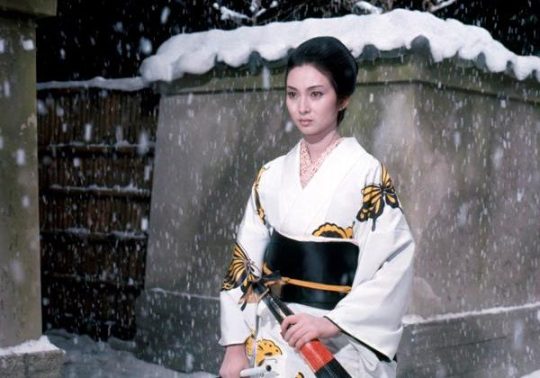
View On WordPress
#Japanese Film Trailers.#Ketsudan Unmei o Kaeta 3.11 Boshi Hinan#Kouin#Koza Mama Utatte! Koza no Mama-san!!#Make-Believers#Nichi Nichi Geijutsu
0 notes
Text

田山メイ子さんの企画に2度目の出演です。前回と同じく、イツロウくんと3人で。普段とは勝手がかなり違うので、結構大変なんですが、前回よりは良くできるかな?と勝手に思ってます。
●2024-05-22(wed) 成城学園前 アトリエ第Q藝術
"Q根たちの競宴 vol.6 第一夜"
act:
〈MONO-NO-KE〉
田山メイ子
Itsuro1×2_6
高橋直康
〈両面宿儺-りょうめんすくな〉
三浦宏予
富士栄秀也
open 19:00 / start 19:30
charge 3000yen / 5000yen(2days)
#Live#Dance#Improvisation#Seijogakuenmae#Atelier Dai Q Geijutsu#Meiko Tayama#Itsuro1×2_6#Naoyasu Takahashi#Hiroyo Miura#Hideya Fujie#即興演奏#成城学園前#アトリエ第Q藝術#田山メイ子#イツロウ1×2_6#高橋直康#三浦宏予#富士栄秀也
1 note
·
View note
Text
Well, um, hiya☆
I've come to life a little here and brought you some interesting features in the characters' spoken language
To begin with, let's look at the male trio of main characters: Naruhodō, Mitsurugi, Odoroki (Wright, Edgeworth, Justice)
Some people know it, some don't, but in Japanese there are many options for how to refer to yourself, i.e. "I" can be said with different pronouns and they are all ranked by gender (there are also gender-neutral ones) and the level of politeness.
The first one we have is Naruhodō.
He always, regardless of the situation, uses the pronoun "boku" (ぼく) in relation to himself.
僕 (ぼく)
僕 (boku) is a first-person pronoun often associated with male speakers. It has earnest, polite, cultured connotations. Overall, 僕 (boku) has a softer, less aggressive than 俺 (ore), another common pronoun with masculine connotations.
Naruhodō uses it both in the first trilogy, when he is 24-26 years old, and after the 7-year gap, when he is 33-35. It doesn't matter if he is in the courtroom or talking to friends - he always uses "boku".
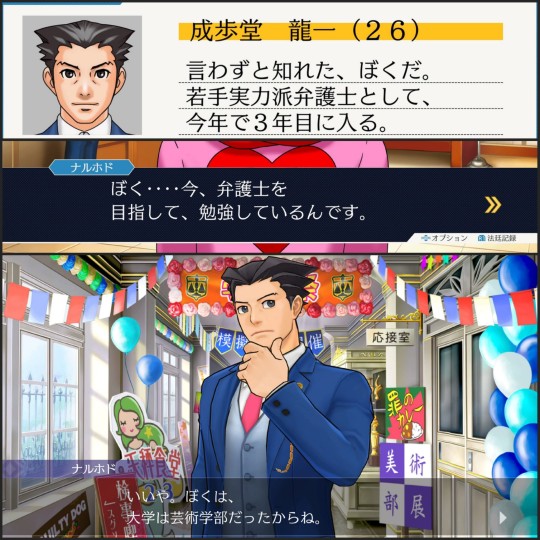
言わずと知れた、ぼくだ。 若手実力派弁護士として、 今年で3年目に入る。
Iwazu to shireta, bokuda. Wakate jitsuryoku-ha bengoshi to shite, kotoshi de 3-nen menihairu.
It goes without saying that it is me. I am a young and talented lawyer, and this is my third year in the industry.
___________________________________________
ぼく・・・・今、弁護士を 目指して、勉強しているんです。
boku ima, bengoshi o mezashite, benkyō shite iru ndesu.
I'm studying to become a lawyer.
___________________________________________
いいや。ぼくは、 大学は芸術学部だったからね。
Ī ya. Boku wa, daigaku wa geijutsu gakubudattakara ne.
No. I entered the arts department at the university.
___________________________________________
When addressing someone, Naruhodo uses pronoun "omae".
お前 (おまえ)
お前 is a second-person pronoun that's masculine and rough — it's often used for cussing! It could also be a way to show affection to close friends, partners, and family in a very casual manner.
It is curious that he only addresses Mitsurugi this way, while he addresses the others (Mayoi, Odoroki, etc.) by name + suffix (Mayoi-chan, Odoroki-kun).
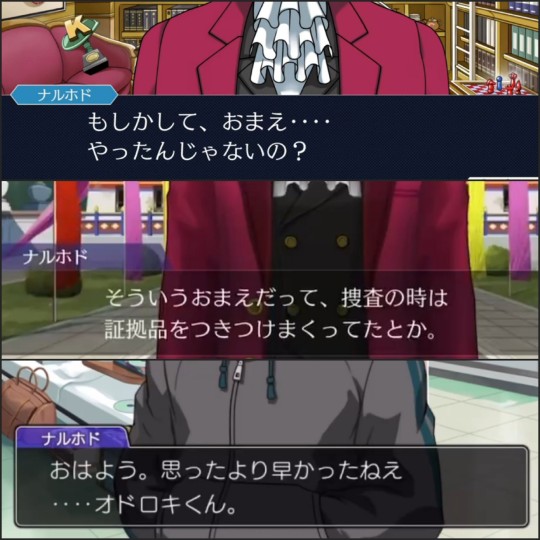
もしかして、おまえ・・・・ やったんじゃないの?
Moshikashite, omae yatta n janai no?
Maybe you... did it?
___________________________________________
そういうおまえだって、捜査の時は 証拠品をつきつけまくってたとか。
Sōiu omae datte, sōsa no toki wa shōko-hin o tsukitsuke makutteta to ka.
Even you, who is like that, apparently presented a lot of evidence during the investigation.
___________________________________________
おはよう。思ったより早かったねえ ・・・・オドロキくん。
Ohayō. Omottayori hayakatta ne e Odoroki-kun.
Good morning. It was earlier than I thought... Odoroki-kun.
___________________________________________
Next up we have Mitsurugi.
Mr. Politeness uses the pronoun "watashi" when referring to himself.
私 (わたし/わたくし)
わたし (watashi) is quite a common first-person pronoun as it's used regardless of gender, and both in casual and formal situations.It also has a certain elegant, sophisticated feel to it.
It also does not change over time, and is used by him both at 24-26 and at 34-35 years old.

私が異議をとなえれば、裁判長は かならず聞き入れるだろう、と。
Watashi ga igi o tonaereba, saiban-chō wa kanarazu kikiirerudarou, to.
If I raised an objection, the judge would certainly listen.
___________________________________________
私が検事の職をまっとうできるのも、 周りの誰かの支えがあってこそ。
Watashi ga kenji no shoku o mattō dekiru no mo, mawari no dareka no sasae ga atte koso.
It is only thanks to the support of those around me that I am able to carry out my duties as a prosecutor.
___________________________________________
礼を言うのは・・・・ 私のほうだ、成歩堂。
rei o iu no wa watashi no hōda, Naruhodō.
I should be the one to thank you, Naruhodo.
___________________________________________
But he has a special attitude towards the informal address "you". And by the way, it depends on the situation Mitsurugi is in, and not on who he is addressing.
Because he uses at least 4 (maybe more, I couldn't catch them all) options of address!
The first is "omae". We have already discussed it, so I will not repeat myself. But the situation in which it is used is when Mitsurugi tries to be cheeky, when he makes fun of others (most often, of course, Naruhodō)
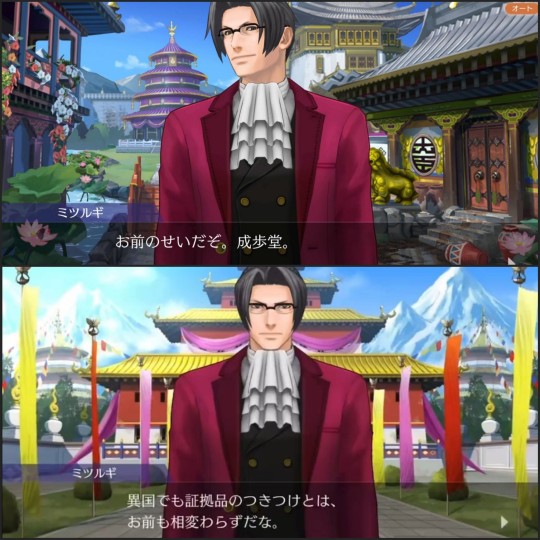
お前のせいだぞ。成歩堂。
Omae no seida zo. Naruhodō.
It's your fault, Naruhodō.
___________________________________________
異国でも証拠品のつきつけとは、
お前も相変わらずだな。
Ikoku demo shōko-hin no tsukitsuke to wa, omae mo aikawarazuda na.
You're still the same, presenting evidence even in a foreign country.
___________________________________________
Next, the address "kimi".
君 (きみ/キミ)
君 (kimi) is a second-person pronoun with various nuances. Some dictionaries define 君 as a pronoun you can use in a friendly way towards someone of equal or lower status. These days, however, the way 君 is perceived varies quite a bit from person to person.
Outside of hierarchical situations like the workplace, 君 is used a lot to sound literary or poetic.
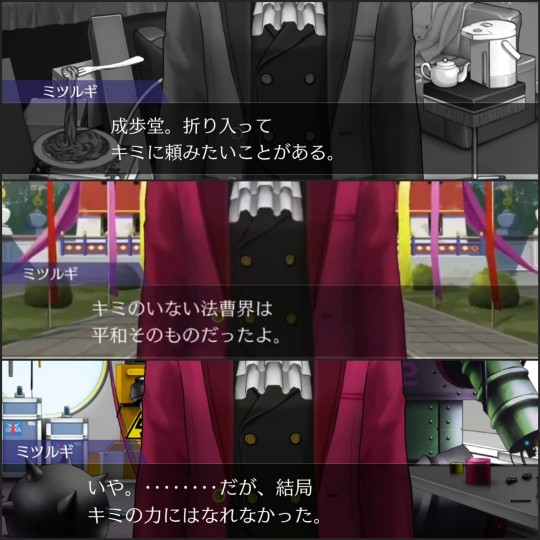
成歩堂。折り入って キミに頼みたいことがある。
Naruhodō. Oriitte kimi ni tanomitai koto ga aru.
Naruhodō. There's something I'd like to ask you.
___________________________________________
キミのいない法曹界は 平和そのものだったよ。
Kimi no inai hōsōkai wa heiwa sonomonodatta yo.
The legal profession would be at peace without you.
___________________________________________
いや。・・・・・・・・だが、結局 キミの力にはなれなかった。
Īya. Daga, kekkyoku kimi no chikara ni hanarenakatta.
No... But in the end, I couldn't be of any help to you.
In the example, Mitsurugi asks Naruhodō for help, so I don't think it's a hierarchy thing. It's more of an equal thing. (Correct me if I'm wrong)
___________________________________________
And then comes the most epic part. Kisama.
貴様 (きさま/キサマ)
貴様 (kisama) is a second-person pronoun that's masculine and rough, it's often in combination with vulgar language!
Although it's associated with masculinity, that doesn't mean it's a pronoun only for men. Even if you don't use 貴様 regularly, it's a great way of expressing your anger.
貴様 can also be a way to show affection in a very casual way towards close friends, partners, and family. In this case, the above example would be playful, rather than showing genuine anger.
Mitsurugi uses it when he gets angry (usually in the courtroom) and sometimes in relation to friends. So, the area of application is justified by its purpose as a pronoun.
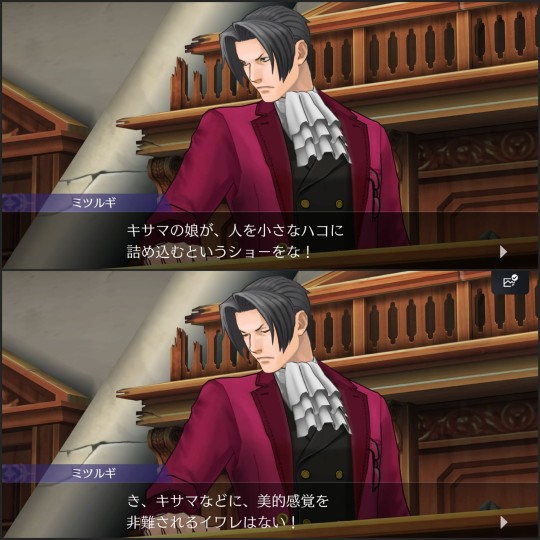
キサマの娘が、人を小さなハコに 詰め込むというショーをな!
Kisama no musume ga, hito o chīsana Hako ni tsumekomu to iu shō o na!
Your daughter puts people into tiny boxes in a show!
___________________________________________
き、キサマなどに、美的感覚を 非難されるイワレはない!
kisama nado ni, biteki kankaku o hinan sa reru iware wanai!
You have no right to criticize aesthetic sense!
And the last one - addressing by name + suffix or without suffix (Mayoi-kun, Naruhodō)
___________________________________________
Next - Odoroki Hosuke (Apollo Justice)
He's a real manly man, haha. He always uses the pronoun "ore".
俺 (おれ/オレ)
俺 (ore) is a first-person pronoun with a strong masculine feel. It sounds "manly" and less gentle than 僕. 俺 is also a pretty casual pronoun and can be seen as vulgar, especially when used in formal situations. In order to use 俺 naturally, the speech style also needs to match the manliness of 俺.
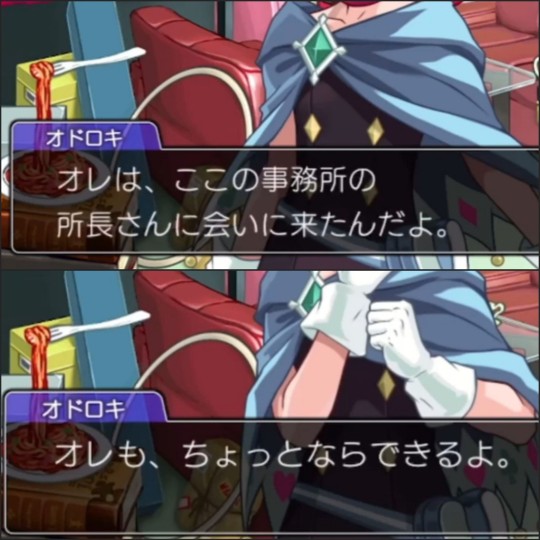
オレは、ここの事務所の 所長さんに会いに来たんだよ。
ore wa, koko no jimusho no shochō-san ni ai ni kita nda yo.
I came here to see the director of this office.
___________________________________________
オレも、ちょっとならできるよ。
A odoroki ore mo, chottonara dekiru yo.
I can do it a little bit magic too.
___________________________________________
But he doesn't bother with addressing others, and always addresses them by name + suffix (Naruhodo-san, Minuki-chan, Garyu-kenji, Mitsurugi-kenji)
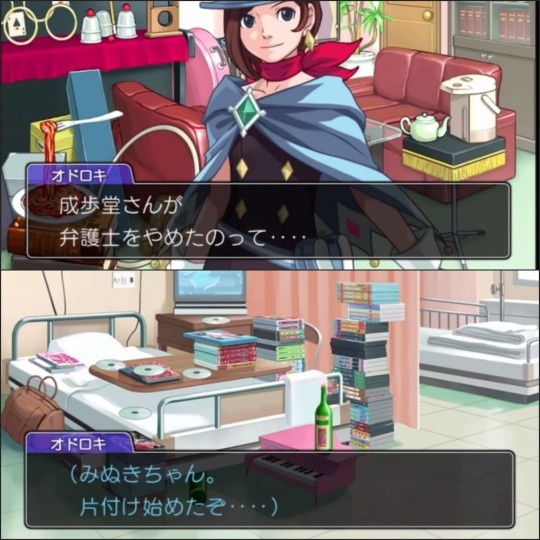
成歩堂さんが 弁護士をやめたのって・・・・
Naruhodō-san ga bengoshi o yameta notte
Naruhodō-san quit being a lawyer...
___________________________________________
(みぬきちゃん。 片付け始めたぞ・・・・)
(Minuki-chan. Katadzuke hajimeta zo)
(Minuki-chan, you're starting to clean up...)
___________________________________________
P.S.
I hope this will clarify the characters a bit and give you a new perspective on them.
One day, I'll do the same with the main female characters (because it takes a lot of time, but I bless those who post screen recordings and screenshots, thanks to them I can quickly find the right moment).
There may be errors and typos, don't be afraid to point them out to me
#ace attorney#gyakuten saiban#naruhodou ryuuichi#phoenix wright#miles edgeworth#mitsurugi reiji#odoroki housuke#apollo justice#omg i did this#time to rest a little#😴#naruhodo ryuichi
385 notes
·
View notes
Text
Moon Troupe new top combi announcement

We have a record breaker on our hands!!
Congrats to Hozuki An, who at ken-19 will set the record formerly held by Oozora Yuuhi for longest tenured in Takarazuka before becoming top; and Amashi Juri, who will be the first top of the 101st class.
Their debut performance will be a national tour of In the Amber-Hued Rain / Grande TAKARAZUKA 110! beginning August 22.
Simultaneously, Kazama Yuno will lead a restaging of Bluff, based on the movie The Sting and first performed by Kuze Seika in 1990, at Tokyo Geijutsu Gekijou and Bow Hall.
68 notes
·
View notes
Text

Geijutsu Shinbunsha Co., Ltd. will publish my art collection book, "Oyogu Yume Wo Mita," on August 10th 🎉
I'd like to express my gratitude to them for their support and belief in bringing this collection to life.
I'd also want to thank Ozaki Ikuo Graphic Design Studio, the clients who agreed to have their work shown, and the music producers who contributed tunes.
More details will be provided as the release date approaches. Thank you for your continuous support! 😊
#artbook#illustration#illustrator#digital art#digital drawing#art work#digital painting#drawing#lofiart#イラスト
77 notes
·
View notes
Text

from Geijutsu Shincho, September issue
'Special feature: Moto Hagio - reading from her sketchbooks, the secrets of her creativity'.
『芸術新潮』9月号
「特集 萩尾望都―スケッチブックから読み解く、創作のひみつ」
19 notes
·
View notes
Text

The Shieldmaiden of Rohan - by Kurai Geijutsu
Éowyn was the daughter of Éomund & Theodwyn and younger sister of Éomer. She was the niece of King Théoden and eventually ended up marrying Faramir (brother of Boromir).
#tolkien legendarium#middle earth#tolkien#the lord of the rings#rohan#éomer#éowyn fanart#éowyn of rohan#éowyn#éowyn & the nazgul#kingdom of rohan#riders of rohan
28 notes
·
View notes
Text










NHK MUSIC SPECIAL Ryuichi Sakamoto Geijutsu wa Nagaku, Jinsei wa Mijikashi (NHKG 2023.07.06)
Google Drive
56 notes
·
View notes
Text
LoZ - Sheikah Arts
Kokoro no Me (心の目, Mind's Eye) is a state that allows those who open it to see the truth. Which includes seeing past illusions as well as granting the ability to see past invisibility & enable them to see & interact with spirits, whether dead or otherwise. Some rare few are also gifted with other talents ranging from limited future/past sight or heightened perception not unlike what one sees from Apollo Justice in the Ace Attorney series.
As one trains their Kokoro no Me, their eyes will begin to slowly encrimson over time before turning a bright, ruby red.
This is a canonical technique, though I've added a couple of things onto the concept.
It takes years of hardwork, dedication, & asetic meditation to achieve it & is considered the birthright of the Sheikah, having originally been taught by their creator deity, whose name has since been lost to time.
The specific way that the Mind's Eye is trained is via a type of asetic training that combines the IRL concepts of Kiko (basically Qigong), Tummo, Aiki-Jūjutsu, yoga, activating the Chakrahs, & just overall spiritual growth & maturation.
I think that it'd also give the power to Scry & possibly even something like Eyes of the Night & Hunter's Mark from DnD. However, Scrying & Hunter's Mark would be the sort of things that a Sheikah would need to train specifically.
For more on the specifics of the Mind's Eye & how it's opened, go here.
---
Tōhi-Jutsu (逃避術, Escape Technique) is an essential art to know for any Sheikah warrior. For all intents & purposes, it's the art of escapology.
However, it's a mostly physical art & doesn't really work on magical bindings or sealing. One could feasibly learn a way to get passed such things, but it would require study into whatever magical binding was used, which would, at the very least, require knowledge of the inner workings of basic magical theory & sealing techniques.
---
Another extremely important skill for a Sheikah to learn is Kankyō Undō no Geijutsu (環境運動の芸術, Art of Environmental Movement; this is a name that I made up), which is an athletic discipline that allows practitioners to traverse just about any environment in the most efficient way possible using their physical abilities. This commonly involves climbing, running, jumping, vaulting, rolling, & other such movements. This is basically parkour, freerunning, & efficient climbing all rolled into one neat little package.
However, there are 2 different variants of this discipline: male & female. And they work very different areas of the body based on how the body moves naturally. Meaning that the male variant focuses more on upper body strength & their higher center of gravity, while the female variant focuses more on lower body strength, their hips, their core, ect. This allows both to excel in ways that are natural to their individual body.
One part of this is Ukemi (受け身, lit. translation, recieving with/through the body), or the art of falling, which allows you to know instinctively how to fall in a way that causes as little damage as possible.
It'd also come with training to be able to use magic to enhance certain capabilities in a way not dissimilar to Step of the Wind, Slow Fall, & Unarmored Movement.
—
The Sheikah art of forging blades is known as Hachi Shita-Kitae (八下鍛え, Eight-Folding Technique) & their techniques have been passed down over several thousands of generations. In the art of bladesmithing, they are especially illustrious.
The technique involves the repeated folding & hammering of the metal to evenly distribute impurities throughout the blade, increasing its hardness & durability. The reason being that the Sheikah live in an area where the iron quality is very poor. So, they use this technique to get around it.
And while, yes, Goron iron is more high quality & more durable, it also tends to be more brittle & very inflexible. Neither are very ideal for bladesmithing as you want your blade to be able to bend a bit, but not just effing shatter entirely. A blade that bends, will typically snap instead of shatter & snapping is much easier to repair than outright shattering. As such, their own iron is still better for forging blades. The Sheikah do use Goron iron for making tools & weapons that don't really need to bend, though. Especially forging hammers, Jōhyō (chained kunai or rope dart), & Kunai.
Interestingly enough, the best iron for blade-making tends to come from either the Gerudo Highlands or any swamp or bog around Hyrule. The reasoning for the swamp/bog is due to Bog Iron, which is a type of iron only found in those areas & are known for having trace amounts of silicon in them, which makes them more naturally flexible. Meanwhile, Highland iron, otherwise known as Dawallaham iron, is excellent due to being both very flexible & very hard at the same time.
Anyway, this technique is used to forge what are known as Kakaritō (カカリ刀). Which is just the overarching category that Sheikah blades fall under.
There have since been new developments in the Sheikah's forging style by a Masamuna family prodigy. The Masamuna family being the oldest & most skilled known Sheikah forging family. Their smithy is located in Rikoka Hills, north of Kakariko. (Inspired by the Second Wind mod for Breath of the Wild.)
One such advancement being Kaijū-Hone Yakin (怪獣骨冶金, Monster Bone Metallurgy), which is the method of melting monster parts down & working them into liquid metal. You don't necessarily need to use only bones & only use them on blades to actually be practicing this. You could weave a whip from the leather of a Lizalfos' tail &, while not Yakin specifically, it still counts as Kaijū-Hone. Though, in.the case of blades, horns are the easiest to go with as they'll melt in open flame.
Toketa Hōseki Shita-Kitae (溶けた宝石下鍛え, Molten Gem-Folding Technique) is the art of liquifying gemstones & folding them into metal to create a blade in order to impart their ingrained, elemental magic upon the weapon. The Hōseki Shita-Kitae actually being a sort of evolution of the Hachi Shita-Kitae as the folding process is essential to integrating the gemstones' magic into the weapon.
For more on the specifics of Sheikah Weapon Smithing & what sorts of weapons they make, go here.
—
Karada Yomijutsu (体読み術, Body Reading Technique) is basically Hellstromism or contact mind-reading. In other words, it is the art of talking & observing someone's facial ticks, body language, & muscle movements to discern their thoughts via their body's instinctive reactions to what is being said or what they're looking at.
For an idea of how this looks, at least in media, I'd recommend watching Now You See Me 1 & 2. While the concept is very sensationalized there, it still gives a decent idea of the idea behind it.
—
Sheikah cuisine tends to focus quite a lot on flavor pairings similarly to South Korean cuisine.
They call it Oishī Shinajīdō (美味しいシナジー道) or the art of delicious synergy. This isn't a thing they do just because; it's both a science & an art form.
Any Itamae (板前) worth their salt studies it. Itamae being a type of skilled master chef.
They also have a branch known as Eiyō Bishokugaku (栄養美食学) or Nutritional Gastronomy. Which is the optimization of food through the use of certain ingredients to strengthen the body in different ways.
It's basically a more scientific version of how the games use food effects.
Though, neither Eiyō nor it's sister concept of Bunka Bishoku (文化美食) are studied as ardently or as widely as Oishī Shinajīdō.
Bunka Bishoku being Cultural Gastronomy, which is the study of the cultural & history behind foods & ingredients.
However, in order to really optimize the effects of food, one needs to practice Hearth Magic, which is basically nutritional food magic. In essence, I believe that the Link of the Wild Era had some sort of talent or forgotten training in the art of gastromagy. Specifically, nutritional gastromagy. As would explain the downright magical effects that he is able to bring out in food. Because something important to remember is that those effects are only usable upon cooking them.
Among the Sheikah, this is referred to as Tabemono no Madō (食べ物の魔道, art of food magic) & practitioners are called Danro Madōshi (暖炉魔道士, hearth mage).
When a fully-trained Itamae combines Eiyō Bishokugaku with Tabemono no Madō, the results are positively magical.
Though, I am of the opinion that what we see Link capable of is mostly instinctual & mostly only based on Hearth Magic & not nutritional Gastronomy. As such, I believe that even if he were to unlock all his memories, his abilities at making magical food would still not have even approached his true full potential simply due to a lack of in-depth, professional knowledge & study from a more scientific perspective.
---
There is also Kiridō (斬道, Cutting Art), the art of the knife. Which is broken down into 2 branches: Kirijutsu & Santoku. Which are 2 different types of knife styles.
Kirijutsu (斬術, Cutting Method) specifically being the martial or self-defensive use of knives, such as Kunai or Kodachi, & is easily adapted to the use of sickles. Meanwhile Santoku refers specifically to the use of the knife in the kitchen.
Santoku (三徳, Three Virtues or Uses) refers to the 3 uses for kitchen knives: slicing, dicing, & mincing.
While one can learn Santoku separately from Kirijutsu if they so desire, it is thought in Sheikah culture that in order to get the full understanding of all that a Hōchō (包丁, Kitchen Knife) is capable of, one must also know how to defend oneself with that Hōchō. Which, while Sheikah-made Hōchō are not designed with the thought of fighting specifically in mind, they are designed to be able to be used in such a way & be effective at it, if necessary. This is due to it being said in Sheikah culture that the best knifefighters know how to use a Kiri to cook just as easily as to fight & vice versa.
As a result, the best Sheikah chefs are also skilled in knifefighting.
Hōchō come in a variety of styles.
Including, but not limited to Gyuto-Bōchō (Beef or Chef's Knife), Yanagiba-Bōchō (Sashimi or Sushi Knife) & Kiritsuke-Bōchō (Executive Chef Sashimi Knife), Santoku-Bōchō (3 Virtues or Multipurpose Knife), Sujihiki-Bōchō (Slicer, Carving, or Meat Knife), Nami-Bōchō (Bread or Cake Knife), Kikusumi-Bōchō (Petty, Utility, or Fine-Detail Paring/Peeling Knife), Honekotsu-Bōchō (Boning Knife), Usuba-Bōchō (Vegetable Knife) & Nakiri-Bōchō (Home-use Vegetable Knife), & Chuka-Bōchō (Cleaver).
While each design has its uses, the Gyuto-Bōchō is considered the most versatile as it is able to dice veggies, slice meat, smash garlic, & chop herbs & nuts. It is most often used to prepare non-Sheikah dishes & can often replace most any non-Sheikah kitchen knife.
The Santoku-Bōchō is likewise very useful as it is used for the 3 virtues of kitchen knives: slicing, dicing, & mincing. It is perfect for slicing, dicing, & mincing fruit, vegetables, fish, & boneless meat. It is thought to be able to accomplish just about anything a non-Sheikah kitchen knife can & is considered a multipurpose Home Chef knife.
Honekotsu-Bōchō is an all-around meat, fish, & boning knife that can be used for anything from delicate filleting & detailed boning, to larger cuts of meat, & even heavy boning depending on the sharpness. It can specifically be unsharpened for heavy work or sharpened for fine detail work. (In terms of meta-narrative, Honekotsu-Bōchō are sort of a fusion between the real world Honesuki-Bōchō & Hankotsu-Bōchō.)
Anyway, when knives are worn down or become broken, they are not merely disposed of as, much like any tool & especially swords, the Sheikah believe that over the years of use that knives develop spirits known as Tsukumogami or tool spirits/gods. When this happens, it's thought that the knife becomes a very personal part of the chef & an extension of themselves, also similar to swords.
And as such, just like with swords, knives are often given burial places, or Hōchō-Zuka (包丁塚, Kitchen Knife Mound).
These Hōchō-Zuka monuments are often used to pray for improved knife & cooking skills.
It is partially due to this reverence that the Sheikah are well-known for having the least wasteful kitchens in Hyrule. As they have a culture of diligent tool maintenance. Meaning resharpening blades, replacing handles, & reviving knives & swords many times over.
As a result, Sheikah blades, both knives & swords, tend to last for literal lifetimes.
(Much of this is based on actual Japanese concepts.)
Anyway, a knife block was a Hōchō-Kaku (包丁角, Kitchen Knife Square), but the knife set itself, especially if it was fully stocked with everything a chef needs, was referred to as a Kamado Nakama (かまど仲間, Oven Companion) as the Sheikah refer to their kitchens as Kamado.
Hōchō-Kaku & Kamado Nakama generally come in 2 types: Katei-Yō (家庭用, Home) & Mamena (まめな, Diligent). As you can likely guess, one is for home-use & one is for professional-use.
Interestingly enough, it is a tradition for a woman's first Hōchō-Kaku to be gifted to her by her husband for their first house together. Generally, those tend to be Katei-Yō unless the man is either marrying a chef or is a chef himself.
---
The Sheikah have several branches of cooking specialty. To become a master of that branch is to become an Itamae (板前) or skilled master chef.
Just a few of the different types of Itamae are Sushi Itamae (寿司板前) or skilled sushi chef, a Yaki-Itamae (焼板前) or skilled grill chef or pitmaster, a Doku-Itamae (毒板前) or a type of skilled master chef who specializes in the preparation of normally poisonous or venomous ingredients before cooking & serving them. There are, of course, other types as well.
Though, even the simple Katei-Ryōrijin (家庭料理人) or homecook is still given a degree of regard.
In fact, Katei-Ryōrijin (家庭料理人) were the ones who developed a method of turning the meat from very old or sick animals tender by periodically transferring meat from the grill to ice or snow or even Ice Fruit & back again, repeatedly. This process causes the meat to shrink & expand, becoming very tender. Melt-in-your mouth tender. It also prevents the meat from ever being overcooked.
It is referred to as Yukinoyono Niku (雪の夜の肉) or loosely "Meat Eaten on a Snowy Night." The technique is now used by Yaki-Itamae because of how deliciously tender it makes the meat.
(This technique is inspired by the Korean Bulgogi method, Seol-ya-myuk, which means the same thing.)
These simple homecooks are thus considered to be natural innovators within the world of food & despite not being classified as official Itamae, are often called Tenpu Ryōrijin (天賦料理人), or natural-gift cooks, bordering on Subarashi Ryōrijin (素晴らしい料理人) or great/wonderful cooks, depending on the situation & the talent of the individual.
---
The Sheikah stealth training is known as Kakusu Tanren (隠す鍛練, Hiding Martial Training) & one way they train this is by wearing Pokkuri Geta, which are sandals with hollow bases that have little bells inside. This causes the bells to jingle while they walk.
However, much like in Dragon Ball where Goku trains with Popo, there is a way to move without disturbing the bells. Which is exactly the goal. Sheikah Warriors will often keep their old Pokkuri Geta as mementos of their training days at the Kasuto Bieldcamp. (The hidden village in TP.)
This technique is called Neko no Sanpo (猫の散歩, Cat Walk) & is part of how the Sheikah learn to become so stealthy.
In real life, Pokkuri Geta are worn by Miko.
---
Tekishutsu (摘出) is also a very useful skill. That being lock-picking. Though, not many actively practice it anymore in the modern era.
---
Sadō Shugi (茶道主義) or teaism is the art of tea-making & the tea ceremony.
Those who practice it tend to be borderline fanatical over it at times.
Think Uncle Iroh from Avatar: the Last Airbender.
I'll go more into the philosophies behind Sadō Shugi later.
---
Shadowfolk Fighting Styles
LoZ Cultural Masterlist 2
12 notes
·
View notes
Text

芸術新潮
2月号
特集「会田誠が考える新しい美術の教科書」
1 note
·
View note
Note
Hello! I really enjoy your meta and analysis for jjk. So I have a question. I've heard many times that Jujutsu Kaisen's title's translation in english is Sorcery Fight. But today I read someone say that this translation isn't really correct since the title has a lot of meaning and Sorcery Fight is insufficient. I don't know anyone aside from you who knows Japanese so I'm wondering if you could tell what the title "Jujutsu Kaisen" actually means? I'm very curious to know about that, I just find Gege's use of language very fascinating and exciting. On that note, what Gege does, is it common in mangas? Or is it actually rare?
@cursedvibes's Japanese is much fresher than mine, I haven't used mine much in over a decade. So he might have better insights.
呪術 - jujutsu - means magic or sorcery and it's spelt normally. The first character can mean curse but it's also a charm. The second one often means "art" or "technique", as in the way that you do something, like in 芸術 geijutsu the capital "A" "Art", or 技術 gijutsu "engineering". But it also holds the meaning of "magic" which is makes jujutsu an example of forming a word from 2 characters with very similar meanings that reinforce each other.
廻戦 - kaisen - is spelt with an older version of the "kai" character. This is what it'd look like in modern slightly simplified kanji: 回戦. It could've been done for aesthetic reasons. It might be some Buddhist reference but I took general Japanese religion classes or about Buddhism in relation to art, so my knowledge was never too deep and that was like 15 years ago. And when I wrote papers on religion one was about Aum Shinrikyo in relation to New Religions, Politics and of course the metro terrorist attack, or about the religion of the Ryuukyuu Archipelago. And JJK strongly draws from Buddhism.
"Sen" means war or battle, but 回戦 is used for fights that are fought in rounds. So you could just interpret it as being this ongoing fight between the sorcerers and curses, where each clash is a round. 回 this character has meanings connected to cycles, instances, rotating, revolving and so on. I wouldn't be surprised if it was connected to some Buddhist concepts. So if we don't use the combined meaning and try to read more into the individual characters you could maybe get to something like a "cycle of war".
But "sorcery fight" isn't an incorrect translation. Especially that one that at least tries to indicate this idea of rounds would be kinda ugly in English. Something like "sorcery match", "sorcery fight next round" sounds even more bland than "sorcery fight" and also would suggest that it's some kind of sport. I mean Mei Mei's turned it into one but is the title only about most recent chapters? While "sorcery cyclical war" or some variation of that would have more gravitas but would also be leaning too heavily on the translator's interpretation of what potential subtext the author had in mind with this title, unless Gege's delved into that in some interview, though I can't recall anything like that.
As to the commonality of Gege's linguistic layering. I'm not some manga or Japanese literature expert but I suspect it's not rare. I'm not sure if it's common per se, though I wouldn't be surprised if it was. It's a pretty simple yet aesthetically pleasing way to add additional layer of meaning and interpretation to the text.
5 notes
·
View notes
Note
♾️
Devil's Manner (Project Sekai ver.) - by Konnichiwa Tanita-san
Odorikata o shiranai / geijutsu no kachi nado wakaranai yatsura ni /
Daraku shite ireba / nani mo mienai mama
(Without knowing how to dance, if those who don't understand the worth of the fine arts are depraved, they won't be able to see anything.)
(Translations from the Vocaloid Lyrics wiki)
#Ceebie speaks#Ceebie answers#Playlist Shuffle Ask Game#Expect a lot of not-English songs if this continues lol I am a weeb#For those I think I'll mainly pick from the translation unless I just like how a certain line sounds or how it's sung#(I do have some English songs but not a lot)
2 notes
·
View notes
Text
Differences in localization and the original pt. 1
I am starting a series of posts with the goal of familiarizing players with some of the differences that localization creates for us in contrast to the original.
Some moments are radically different, misleading and causing controversy, while some do not change the essence of what is happening, but are still noticeably different
Disclaimer: these posts will be written solely for the purpose of familiarization; I do not force anyone to play the game in Japanese, because you are free to choose the version of the game that is comfortable for you. I just noticed some moments and want to share them with you.
The localization of Gyakuten Saiban (Ace Attorney) is essentially good, but there are some moments, IMHO, that I personally would not adapt or change in any way
One of the most serious changes, which, in my opinion, should not have been touched at all, is Mitsurugi's (Edgeworth) phobias.
As if case 1-4 never happened.
In the Japanese version, when examining the files in Mitsurugi's office, Naruhodō will be perplexed about the need for such high shelves - they could collapse during an earthquake.
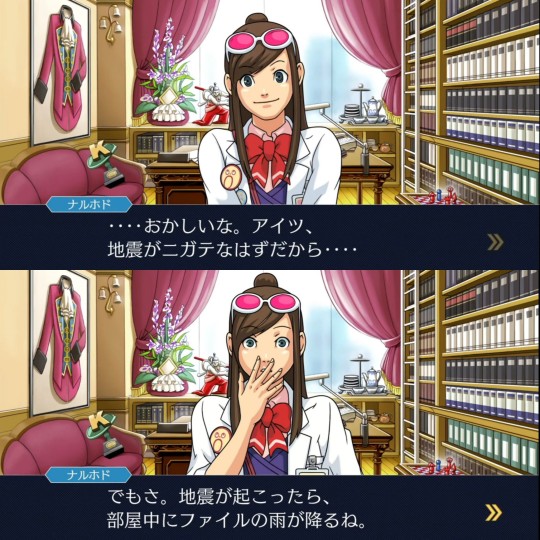
・・・・おかしいな。アイツ、 地震がニガテなはずだから……
Okashī na. Aitsu, jishin ga nigatena hazudakara……
...That's strange. He's supposed to be bad with earthquakes...
でもさ。地震が起こったら、 部屋中にファイルの雨が降るね。
demo sa. Jishin ga okottara, heya-chū ni fairu no amegafuru ne.
But if an earthquake happens, files will rain down all over the room.
In the localization (for some reason) at this point Mitsurugi was given a fear of heights. For what reason... I don't understand

___________________________________________
Next, another big difference is Naruhodo's food preferences
In the Japanese version, Tomi the clown offers him miso ramen (which is cooked in chicken broth and miso), which Naruhodo refuses and says that he prefers tonkotsu ramen (cooked in pork broth and boiled pork is added to it).
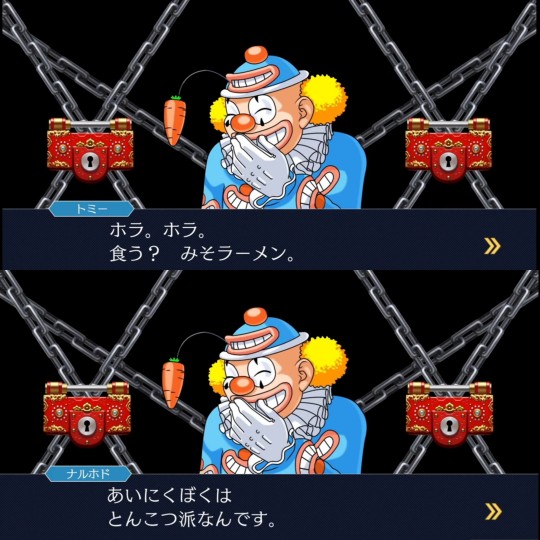
ホラ。ホラ。 食う? みそラーメン。
hora. hora. Kuu? Miso rāmen.
Look. Look. Want some miso ramen?
あいにくぼくは とんこつ派なんです。
ainiku boku wa tonkotsu-hana ndesu.
Unfortunately, I prefer tonkotsu (ramen).
That is, Naruhodo literally says that he would prefer pork, not chicken.
What about the localization? It's the other way around.
The clown offers him a burger (the patties for which are usually made from beef and pork), but he says that he would rather choose a chicken sandwich.
Why?

___________________________________________
Vending machine in 1-3
I have no complaints about its contents (it is adapted), but here another preference of Naruhodo is lost
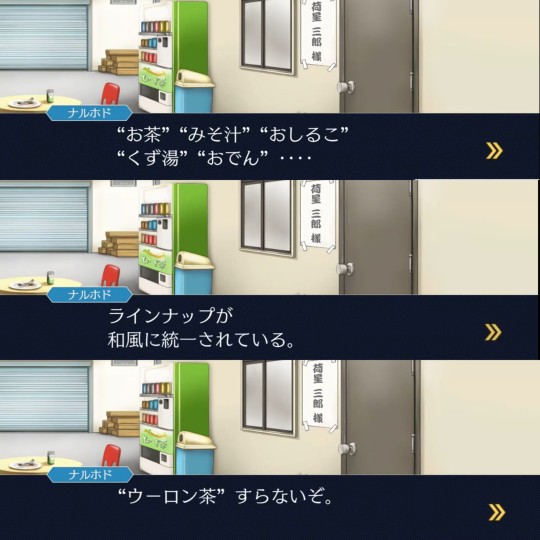
“お茶”“みそ汁”“おしるこ” “くず湯”“おでん”・・・・
“ocha” “misoshiru” “o shiruko” “kuzu yu” “oden”
"Tea" "Miso soup" "Oshiruko" "Kudzu soup" "Oden" ...
ラインナップが 和風に統一されている。
rain'nappu ga wafū ni tōitsu sa rete iru.
The lineup is unified in Japanese style.
“ウーロン茶”すらないぞ。
“ūron cha” sura nai zo.
There's not even "oolong tea."
In the Japanese version, reading the menu of the vending machine, Naruhodo annoyedly comments that "there is not even oolong tea". He literally names the tea he likes!
In the localization, he is disappointed that the food in the vending machine is too... ordinary, and he was expecting something that is not usually sold there (popcorn).

___________________________________________
Naruhodō University
Case 3-1 is very rich in information about the young Naruhodō, including the name of the university he attended
In the Japanese version, it is Yumei University (the same university where his ancestor Ryunosuke Naruhodō studied during the Meiji era - then it was called Yumei Imperial University), which creates an important reference to Dai Gyakuten Saiban (The Great Ace Attorney)
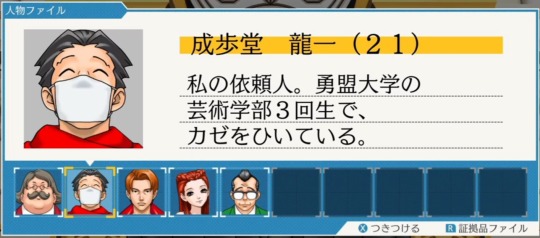
私の依頼人。勇盟大学の 芸術学部3回生で、 カゼをひいている。
watashi no iraijin. Yūmei daigaku no geijutsu gakubu 3-kaisei de, kaze o hīte iru.
My client. A third-year student in the art department at Yumei University, suffering from a cold.

In the localization, he studies at Ivy University, as if referring to the famous Ivy League (elite universities).
A very good decision that shows Naruhodō's abilities and the high quality of his education (my clever boy)
___________________________________________
Interesting addition
And the last one for today, a conversation with Mask in the detention center
When Yusaku (Ron) tells the story of the allegedly lost vase, Naruhodō makes a comment about the absurdity of his story

(・・・・どうも、ハナシが アヤフヤだなあ・・・)(dōmo, hanashi ga ayafuya da nā)
(... I guess the story is a bit vague...)
The localization decided to make a reference to Naruhodō's education in the field of art, and he compares Mask's story to the surreal paintings of Dali.

A nice addition, but still different from the original version.
___________________________________________
In total, in my opinion, 3 unsuccessful changes out of 5.
If you also noticed any differences - feel free to tell us about them. Let's educate ourselves together.
It will be a bit more difficult with the subsequent parts, because I can't buy the Japanese version of TGAA (it is only available to a certain list of countries), and I don't have the new Apollo trilogy and the Investigations duology to check every little thing (and I don't have an extra $80), and those who record the walkthrough do not always check every clue, where the contradictions lie.
140 notes
·
View notes